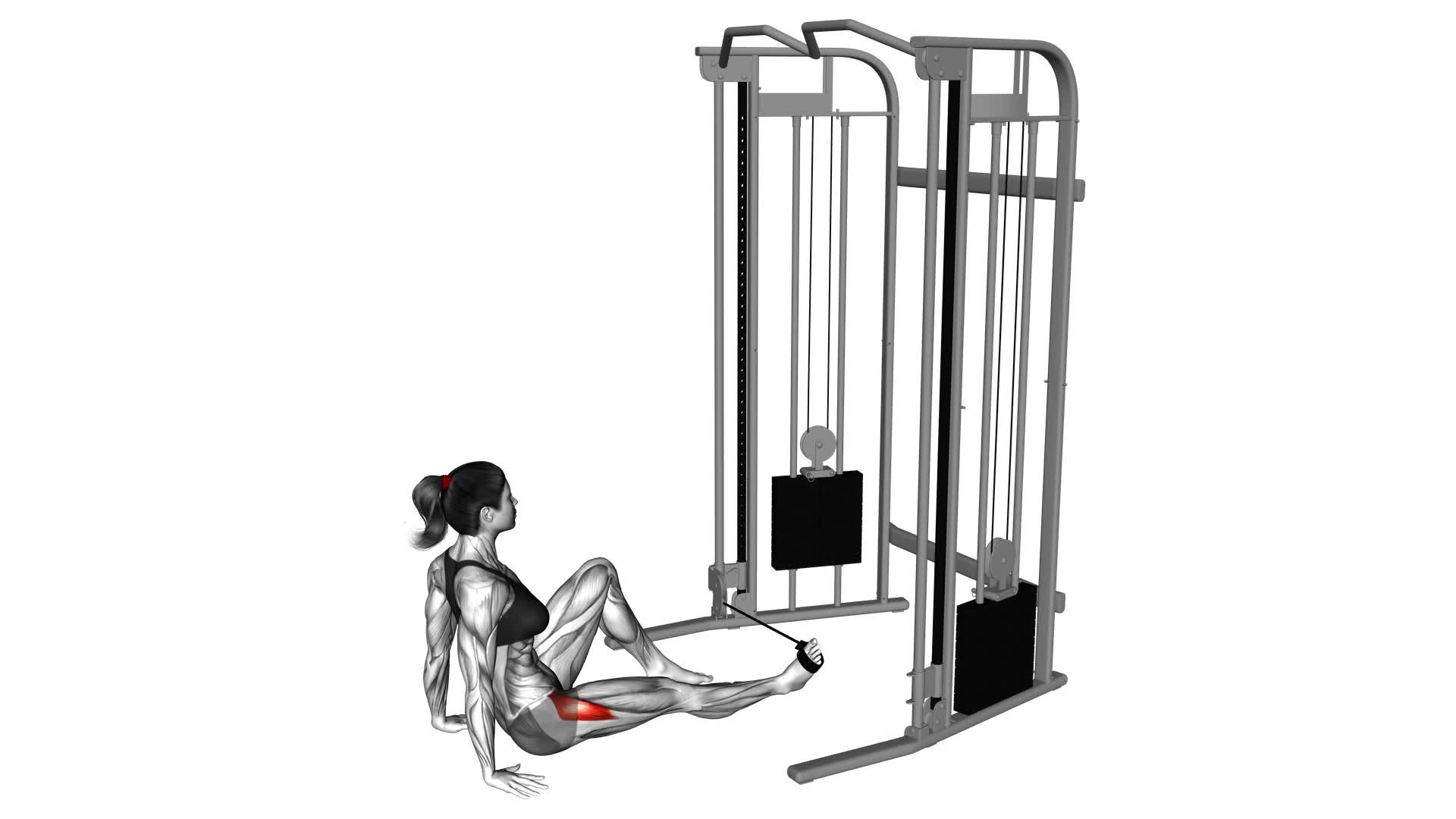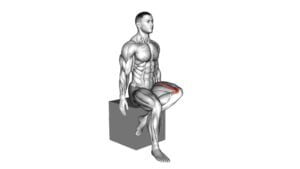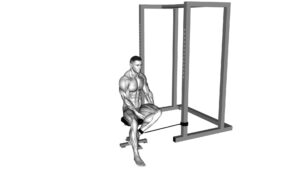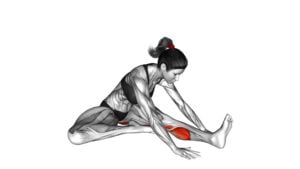Seated Hip External Rotation (female) – Video Exercise Guide & Tips

Are you looking to strengthen and improve flexibility in your hips? Look no further than seated hip external rotation exercises.
Watch This Exercise Video
In this video exercise guide, we'll show you the proper form and technique for this effective exercise. With just a few minutes a day, you can target those hip muscles and reap the benefits of increased mobility and strength.
Get ready to feel the burn and transform your hip health!
Key Takeaways
- Seated hip external rotation helps increase hip mobility and improve hip joint stability.
- It strengthens the hip muscles and reduces the risk of injury.
- Seated hip external rotation enhances the ability to perform daily activities and sports.
- Proper form and technique, along with the use of modifications and progressions, are important for effective seated hip external rotation.
Benefits of Seated Hip External Rotation
You will experience increased hip mobility and improved hip joint stability through seated hip external rotation exercises. The benefits of these exercises are numerous and can greatly enhance your overall hip function.
By engaging in seated hip external rotation exercises, you can strengthen the muscles surrounding the hip joint, such as the glutes and hip external rotators. This increased strength can lead to improved stability in the hip joint, reducing the risk of injury and enhancing your ability to perform daily activities and sports with ease.
Additionally, seated hip external rotation exercises can also help to increase your hip mobility. By actively moving your hip joint through its full range of motion, you can improve the flexibility and range of motion in the muscles and ligaments surrounding the hip. This can be particularly beneficial for individuals who experience tightness or stiffness in the hip area.
To maximize the benefits of seated hip external rotation exercises, it's important to consider modifications and progressions. If you're a beginner, you may start with simpler variations of the exercise, gradually increasing the difficulty as your strength and flexibility improve. Adding resistance bands or weights can also provide additional challenges and further enhance the benefits of these exercises.
Equipment Needed for Seated Hip External Rotation
To properly perform the seated hip external rotation exercise, you'll need the necessary equipment for rotation. These include tools such as resistance bands or cables, a sturdy chair or bench, and possibly a mat for added comfort.
Having the proper gear for rotation will ensure that you can effectively target and strengthen your hip muscles while maintaining stability and safety throughout the exercise.
Necessary Equipment for Rotation
To perform seated hip external rotation exercises, it's important to have the necessary equipment.
The equipment needed for rotation includes a yoga mat or exercise mat to provide cushioning and support for your body during the exercise.
Additionally, you'll need a chair or bench to sit on while performing the exercise. This will help stabilize your body and ensure proper form.
Another essential item is a resistance band or loop. This will be used to add resistance to the exercise and help strengthen the hip muscles.
Lastly, you may want to have a towel or cushion for added comfort and support.
Having these necessary equipment will allow you to perform seated hip external rotation exercises effectively and safely.
Proper Tools for Rotation
To properly perform seated hip external rotation exercises, you'll need specific equipment. Here are four essential rotation tools and equipment options you can consider:
- Resistance Band: This band provides resistance and helps strengthen your hip muscles during the rotation exercise. Choose a band with appropriate resistance levels based on your fitness level.
- Yoga Block: Placing a yoga block between your knees can help maintain proper alignment and engage your hip muscles more effectively during the exercise.
- Stability Ball: Using a stability ball as a seat adds an extra challenge to the exercise by engaging your core muscles while working on hip rotation.
- Dumbbell or Medicine Ball: Holding a dumbbell or medicine ball in front of you can increase the intensity of the exercise and help improve hip strength and stability.
With these rotation tools and equipment options, you can optimize your seated hip external rotation exercises and achieve better results.
Now, let's move on to the next section where we'll discuss the essential gear for rotation.
Essential Gear for Rotation
What equipment do you need for seated hip external rotation exercises to optimize your workout?
When it comes to gear options, there are a few items that can enhance your experience and effectiveness.
One essential piece of equipment is a resistance band, which adds resistance and helps target the muscles in your hips. You can choose from different levels of resistance to match your fitness level and progression.
Another great option is a stability ball, which provides an unstable surface and engages your core muscles while performing the exercise.
Additionally, using a yoga block or a folded towel can help support your knee and maintain proper alignment during the movement.
Proper Form and Technique for Seated Hip External Rotation
Ensure your seated hip external rotation exercise is performed with proper form and technique. To make the most out of this exercise, follow these four tips:
- Keep your back straight: Sit tall with your spine aligned and shoulders relaxed. Avoid slouching or leaning forward, as this can compromise the effectiveness of the exercise.
- Engage your core: Before starting the movement, activate your abdominal muscles to stabilize your torso. This will help maintain proper posture and prevent any unnecessary strain on your back.
- Control the movement: Slowly rotate your leg outwards, focusing on using the muscles of your hip. Avoid any jerking or swinging motions. Keep the movement smooth and controlled throughout.
- Maintain proper alignment: Ensure that your knee and foot stay in line with your hip throughout the exercise. This will help target the muscles involved in hip external rotation more effectively.
If you find the seated hip external rotation challenging or need to modify the exercise, you can use a resistance band or loop around your thighs to provide added resistance. Alternatively, you can also try standing or lying down variations of the exercise.
Modifications and Progressions for Seated Hip External Rotation
Now, let's explore some alternative exercise options and ways to increase the difficulty level for seated hip external rotation.
These modifications and progressions can help you challenge your muscles in new ways and continue to make progress in your fitness journey.
By incorporating these variations into your routine, you can target different muscle groups and enhance your overall strength and flexibility.
Alternative Exercise Options
To further challenge yourself and improve your seated hip external rotation, regularly incorporate alternative exercise options. Here are four exercise variations that can help increase muscle activation and make your workout more effective:
- Resistance Band Hip External Rotation: Attach a resistance band around your knees and sit in the same position as the seated hip external rotation exercise. Instead of using a weight plate, focus on pushing against the resistance band as you rotate your hips outward.
- Swiss Ball Hip External Rotation: Sit on a Swiss ball with your feet flat on the ground. Place a weight plate between your knees and perform the hip external rotation exercise while maintaining balance on the ball.
- Side-Lying Hip External Rotation: Lie on your side with your knees bent and hips stacked. Place a weight plate on the top knee and lift your top leg up while keeping your hips stable.
- Standing Hip External Rotation: Stand upright with your feet hip-width apart. Attach a resistance band to a fixed object and loop it around your ankle. Rotate your leg outward against the resistance of the band.
Incorporating these alternative exercises into your routine will help you target your hip external rotators from different angles and maximize your results.
Increasing Difficulty Level
To challenge yourself further and continue improving your seated hip external rotation, you can modify and progress the exercise in various ways.
One way to increase the intensity is by using a resistance band. Simply place the band around your knees or ankles and perform the exercise as usual. The resistance provided by the band will engage your hip muscles even more.
Another advanced variation is to perform the seated hip external rotation exercise on an unstable surface, such as a stability ball or a foam pad. This will require more stability and core engagement, adding an extra challenge to the exercise.
Additionally, you can increase the difficulty by holding a dumbbell or a medicine ball while performing the movement. Remember to start with lighter weights and gradually increase as you become stronger and more comfortable with the exercise.
Common Mistakes to Avoid During Seated Hip External Rotation
One common mistake to avoid during seated hip external rotation is letting your knees collapse inward. This can happen when the muscles that externally rotate the hip are weak or when there's a lack of awareness of proper form.
To ensure you perform this exercise correctly and effectively, here are four common mistakes to avoid:
- Allowing the knees to cave in: Keep your knees in line with your toes throughout the movement. This will engage the correct muscles and prevent unnecessary strain on the knee joint.
- Using momentum: Avoid using momentum to swing your legs outwards. Instead, focus on controlled movements and engage the hip muscles to perform the rotation.
- Not maintaining a neutral spine: Keep your back straight and avoid rounding or arching your spine during the exercise. Engage your core muscles to stabilize your posture.
- Neglecting to warm up: It's crucial to warm up your hip muscles before performing seated hip external rotation. This will help prevent injuries and improve your range of motion.
By avoiding these common mistakes, you can ensure proper form and maximize the benefits of seated hip external rotation.
Now, let's move on to the next section, where we'll discuss tips for getting the most out of this exercise.
Tips for Getting the Most Out of Seated Hip External Rotation
To maximize the benefits of seated hip external rotation, focus on proper technique and engage your muscles throughout the movement. By following these tips, you can improve flexibility and prevent injuries.
Firstly, make sure to maintain good posture throughout the exercise. Sit up straight with your back against the chair and keep your core engaged. This will help to stabilize your body and target the correct muscles.
Secondly, start with light weights or resistance bands and gradually increase the intensity as your strength improves. Remember, it's better to start with less weight and perfect your form than to use heavy weights and risk injury.
In addition, be mindful of your range of motion. Don't force your legs to go beyond what feels comfortable. Listen to your body and respect its limits. Over time, with consistent practice, you'll gradually increase your flexibility.
Lastly, don't rush the exercise. Slow and controlled movements are key to getting the most out of seated hip external rotation. Focus on squeezing your glutes and engaging your hip muscles throughout the entire range of motion.
Frequently Asked Questions
How Often Should I Perform Seated Hip External Rotation Exercises?
To get the most out of seated hip external rotation exercises, it's important to consider frequency. How often you should perform these exercises depends on your fitness goals and individual needs.
Regularly incorporating them into your workout routine can help improve hip mobility, strengthen the hip muscles, and prevent injuries. It's generally recommended to aim for 2-3 sessions per week, but consult with a fitness professional to determine the best frequency for you.
Can Seated Hip External Rotation Exercises Help With Knee Pain?
Seated hip external rotation exercises can be beneficial for knee pain. By strengthening the muscles around your hip joint, these exercises help stabilize the knee and reduce stress on it.
To perform this exercise, sit on a chair with your feet flat on the ground. Keep your knees and feet together, then rotate one leg outwards as far as comfortable. Hold for a few seconds, then return to the starting position. Repeat on the other side.
Is It Safe to Perform Seated Hip External Rotation Exercises if I Have a Hip Injury?
Performing seated hip external rotation exercises with a hip injury requires safety precautions and modifications.
It's important to consult with a healthcare professional before attempting these exercises to ensure they're appropriate for your condition. They may recommend alternative exercises or modifications to prevent further injury.
Seated hip external rotation exercises can be beneficial for improving hip strength and mobility, but it's crucial to prioritize your safety and follow the guidance of your healthcare provider.
Can Seated Hip External Rotation Exercises Help Improve Sports Performance?
Seated hip external rotation exercises can greatly improve your sports performance. By increasing mobility and strengthening the muscles responsible for hip rotation, these exercises can help you move more efficiently and with greater power during sports activities.
This improved hip function can enhance your agility, speed, and overall athletic performance. Additionally, by targeting the muscles surrounding the hip joint, these exercises can help prevent injuries by improving stability and reducing the risk of imbalances or compensations during movement.
Are There Any Specific Warm-Up Exercises I Should Do Before Attempting Seated Hip External Rotation Exercises?
Before attempting seated hip external rotation exercises, it's important to warm up properly. There are specific warm-up exercises you can do to prepare your hips for this movement. These exercises can help increase blood flow, improve flexibility, and reduce the risk of injury.
Conclusion
In conclusion, seated hip external rotation is a beneficial exercise for strengthening the hip muscles and improving hip mobility. It can be done with minimal equipment and can easily be modified or progressed to meet individual fitness levels.
By maintaining proper form and avoiding common mistakes, you can maximize the effectiveness of this exercise. Remember to always listen to your body and consult with a professional if you have any concerns or questions.
Start incorporating seated hip external rotation into your workout routine for stronger and more flexible hips.

Author
Years ago, the spark of my life’s passion ignited in my mind the moment I stepped into the local gym for the first time. The inaugural bead of perspiration, the initial endeavor, the very first surge of endorphins, and a sense of pride that washed over me post-workout marked the beginning of my deep-seated interest in strength sports, fitness, and sports nutrition. This very curiosity blossomed rapidly into a profound fascination, propelling me to earn a Master’s degree in Physical Education from the Academy of Physical Education in Krakow, followed by a Sports Manager diploma from the Jagiellonian University. My journey of growth led me to gain more specialized qualifications, such as being a certified personal trainer with a focus on sports dietetics, a lifeguard, and an instructor for wellness and corrective gymnastics. Theoretical knowledge paired seamlessly with practical experience, reinforcing my belief that the transformation of individuals under my guidance was also a reflection of my personal growth. This belief holds true even today. Each day, I strive to push the boundaries and explore new realms. These realms gently elevate me to greater heights. The unique combination of passion for my field and the continuous quest for growth fuels my drive to break new ground.







